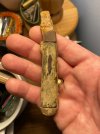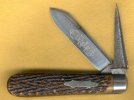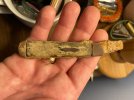- Joined
- Sep 13, 2021
- Messages
- 1,494
Can anyone give me a manufacturer and ballpark time frame, please? I found it while metal detecting my wife’s family’s Civil War-era farmhouse. I’m guessing it’s from my father-in-law and his brothers growing up. Maybe their dad.
One thing is for sure - with two broken blades, someone got their money’s worth out of it.


One thing is for sure - with two broken blades, someone got their money’s worth out of it.






